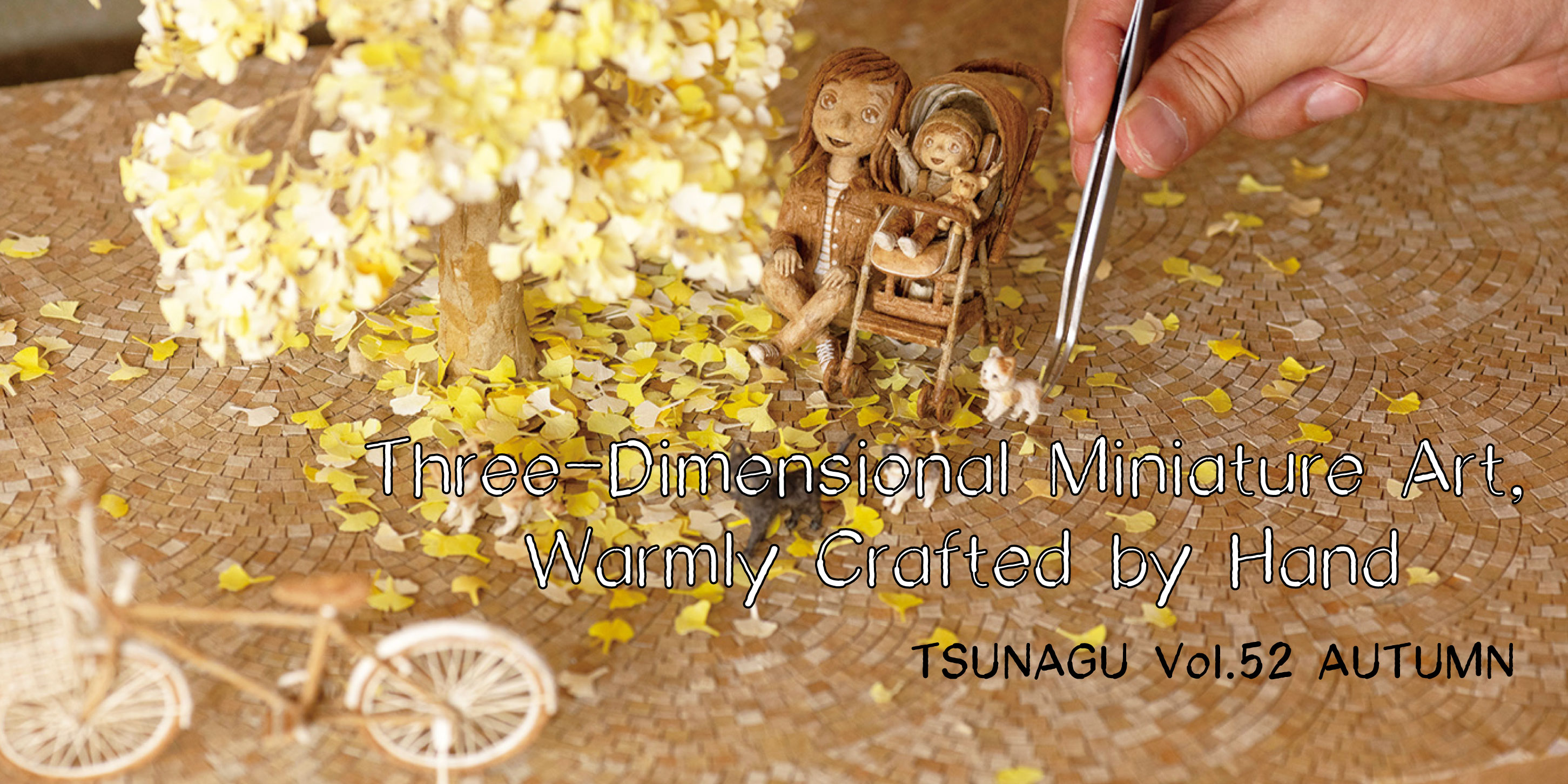
Miniature worlds imbued with a spirit of kindness capture scenes from the day-to-day lives of charming human figures and animals. Artist Kazuhiro Kanazawa creates three-dimensional sculpted works entirely out of paper, making not only palm-sized people and animals, but their detailed surrounding scenery as well, down to the foliage on trees and cobblestone streets. Kanazawa expends tremendous time and energy to create all this by hand himself, producing works filled with a curious charm that bring feelings of happiness to viewers.
Kazuhiro Kanazawa
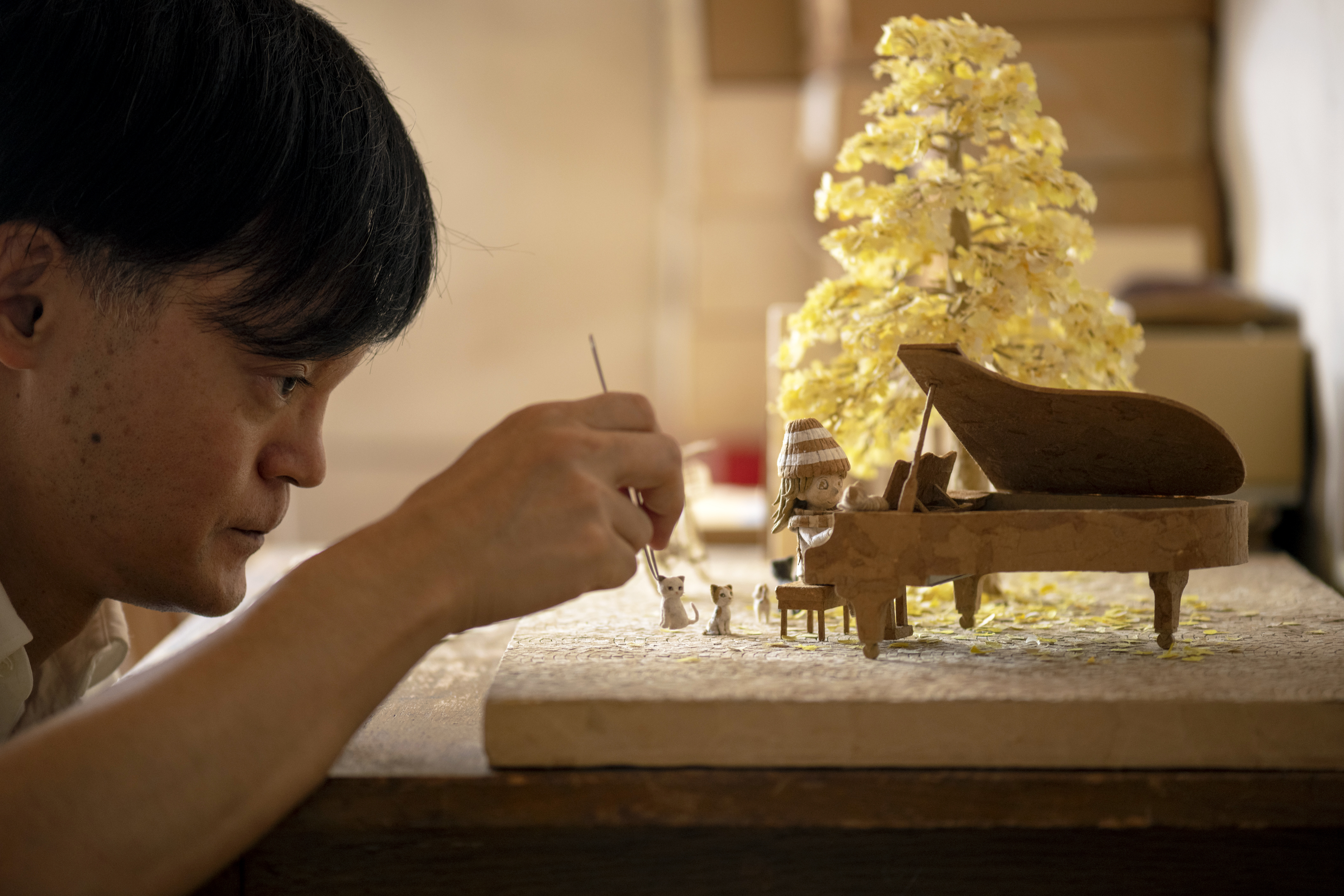
Born in 1974 in Aichi Prefecture. Graduated from the Visual Communication Design Course in the Faculty of Design at Kyoto Seika University in 1998. After working as a graphic designer, begins his career as an independent artist in earnest in 2003. His works gained acclaim in solo exhibitions and other related events, and many are used in book designs, corporate advertisements, calendars, CD jackets, and so on. A broadly active artist who not only creates original works but also accepts custom orders from companies and individuals.
Dedication to creating work expressing the unique texture and softness of paper
Miniature worlds imbued with a spirit of kindness capture scenes from the day-to-day lives of charming human figures and animals. Artist Kazuhiro Kanazawa creates three-dimensional sculpted works entirely out of paper, making not only palm-sized people and animals, but their detailed surrounding scenery as well, down to the foliage on trees and cobblestone streets. Kanazawa expends tremendous time and energy to create all this by hand himself, producing works filled with a curious charm that bring feelings of happiness to viewers.
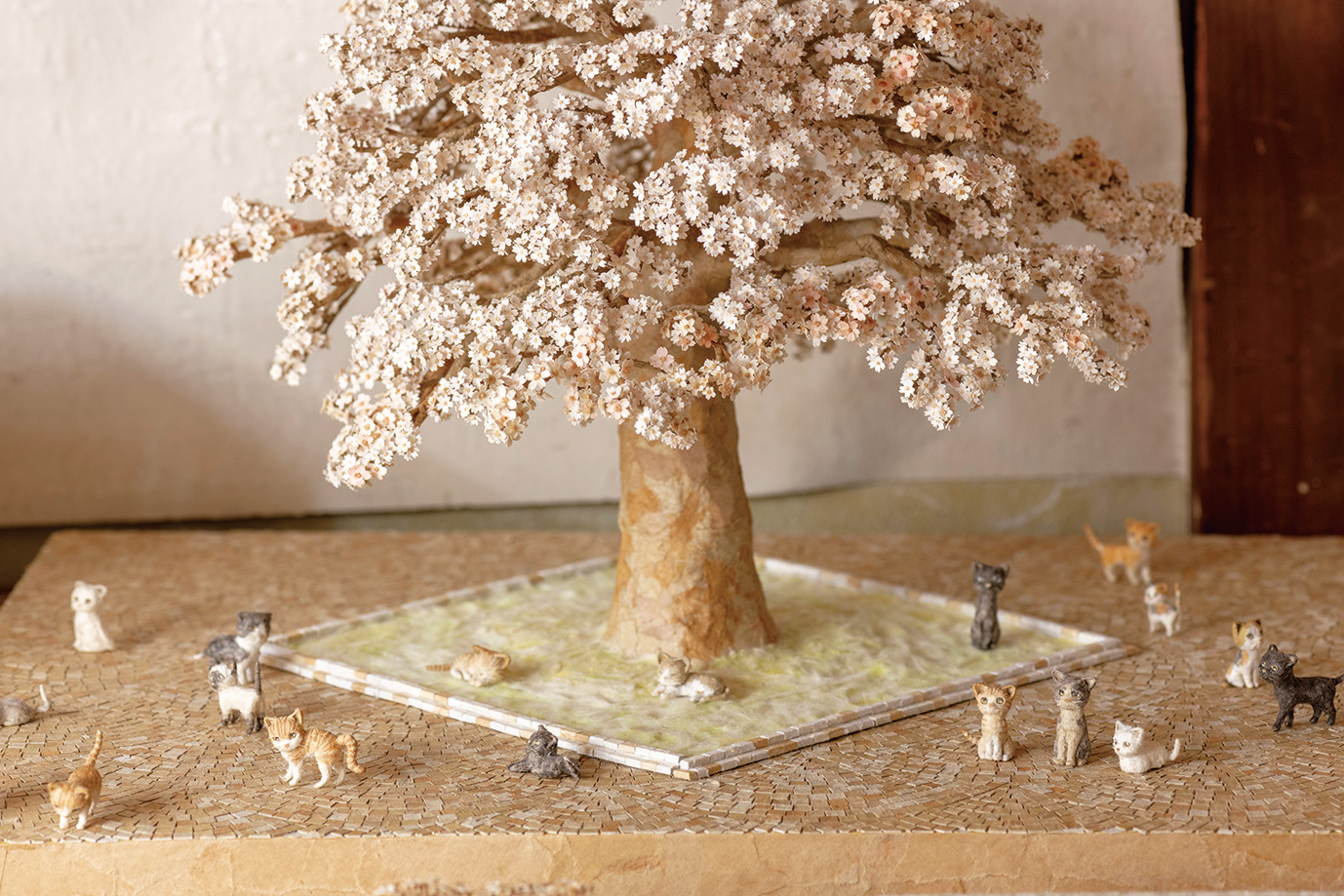
- 拡大
- Cherry blossom
These nice little miniatures are sized to fit in the palm of a hand yet feature intricate detail. While the smoothness of their texture suggests they could be crafted out of clay, the material used in their construction is paper alone. Artist Kazuhiro Kanazawa creates three-dimensional sculpted works using familiar forms of paper — from washi to cardboard, thick packaging paper, and more — to express an original worldview all his own. With his art, he creates not only miniature-sized figures of people of all ages and animals such as cats and birds, but scenes brimming with the flavor of everyday life, complete with trees, park benches, fallen leaves, cobblestones… One of Kanazawa’s works presents a cherry tree in full blossom (center of the page at right) using around 10,000 petals. His free-hand process of cutting out bits of paper one by one and affixing them in the form of cherry blossom petals for this work took him five years.
“Of course, it took that much time because I was working on other art concurrently, but I do like to put as much time and energy into my work as I can get away with. While by no means ‘efficient,’ it does enable me to express a textural feel and softness attainable only with hand crafting,” explains the artist.
Close examination of these works of art created with his iterative processes, which involve tremendous expenditure of time and energy, are enough to make viewers sigh in astonishment and admiration.
Most of the paper Kanazawa uses in his artwork consists of ordinary forms of paper of the kind indispensable to daily life, with a focus on types that would likely have been destined for the trash originally: from cardboard used to pack products to wrapping paper used as cushioning, used envelopes, thick packaging paper, and more.
This approach reflects a philosophy of “upcycling”. Unlike ordinary recycling where the paper may be made back into a raw material to be reused, with upcycling, paper no longer needed for its original purpose is used as is and made into a fresh new form.
“The washi I use is an exception, but other than that, all the materials I use consist of paper that is no longer needed. It’s an approach you don’t see other people taking much. I wondered if working with the original textures and hues of the paper might enable me to express a worldview of my own. The cardboard used by Amazon has a little stronger reddish tinge to it, for instance, and even with the same type of toilet paper, the level of water solubility can vary from one country to another. Friends will even bring back paper for me that they find overseas, so it’s not only paper that I’ve found on my own. Paper is just endlessly fascinating to me!”
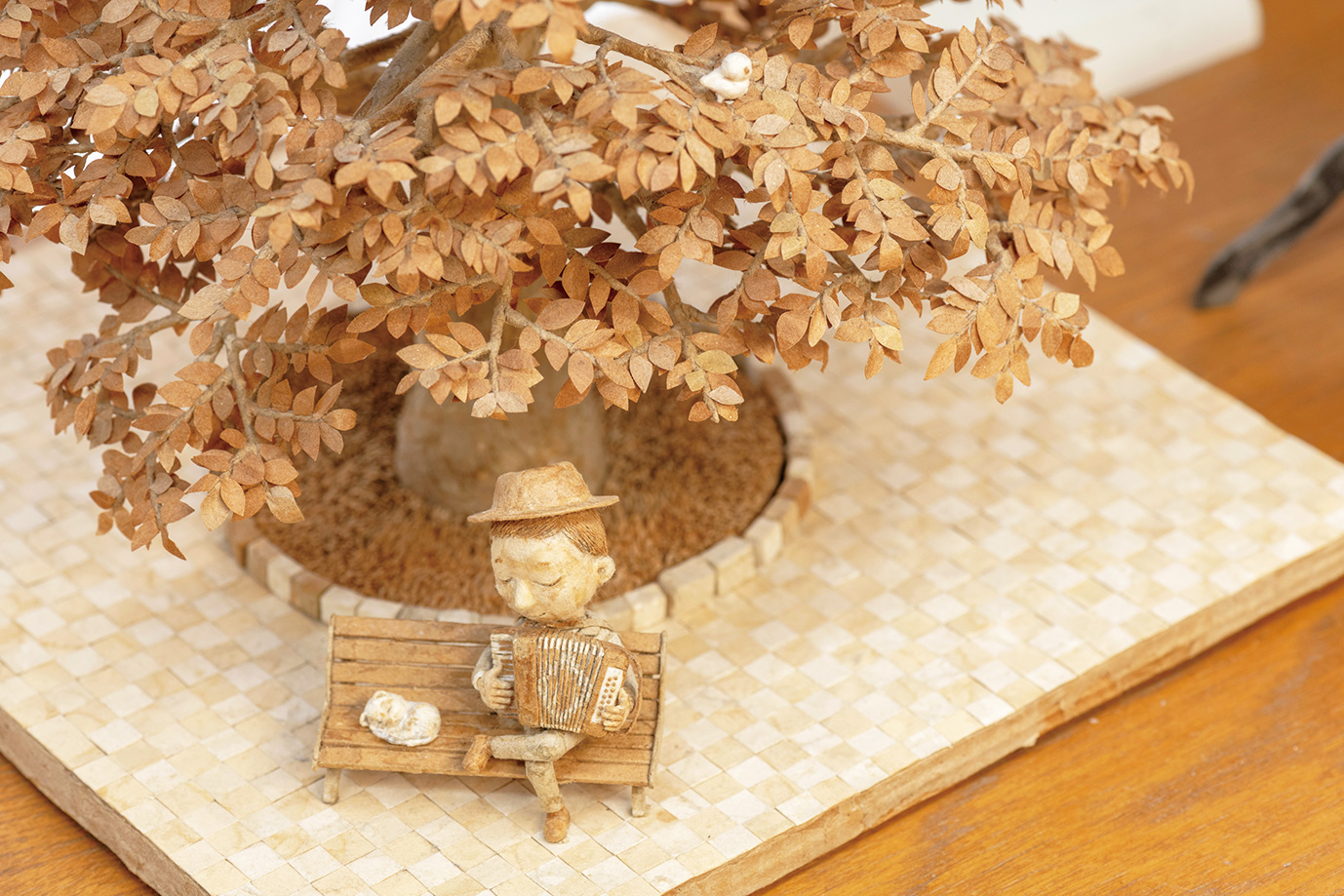
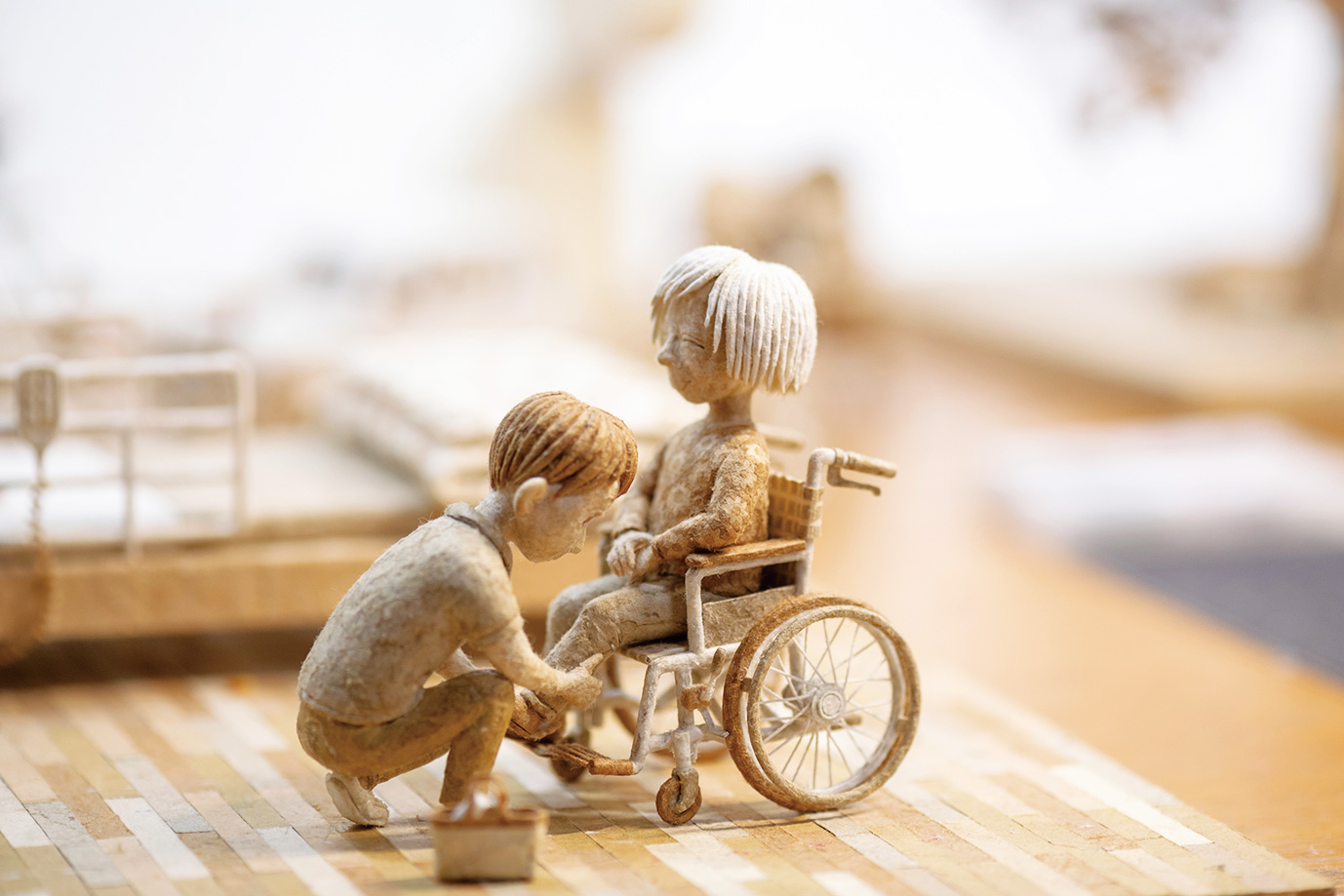
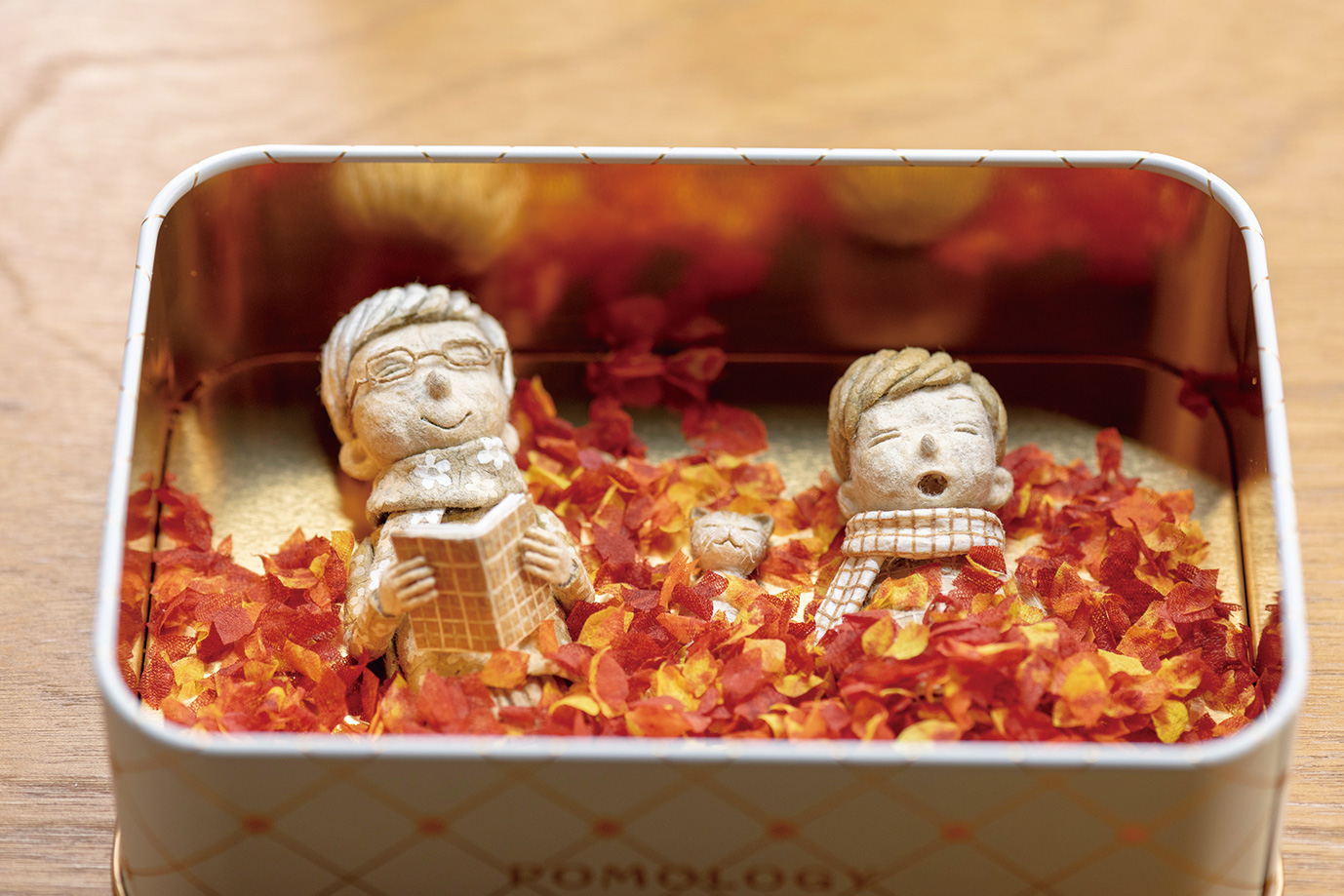
With most papercrafting, the paper is cut and pasted to create three-dimensional modeled forms. Kanazawa’s crafting process, however, gets off to a different start. For human and animal figures, he first applies wood glue to tissue paper, then kneads it into a papier-mâché-like consistency by hand. After roughly molding parts such as the torsos and heads, he pastes together thinly torn pieces of paper with tweezers and uses tools such as design knives, detailing rods, ribbon sculpting tools, and
needle files to bring out more intricate detail. His work involves repeated processes of meticulous, subtly detailed work: pasting together layer upon layer of little bits of paper with varying textures and color tones, as well as forming and attaching minute, threadlike strands of twisted paper one by one, scratching the surface of the paper with the blade of a cutter to make it fluffy, and more to bring each piece to completion.
“All my methods are self-taught. I felt an aversion to imitating others and arrived at this technique as I pursued my own original art form,” he explains. Without relying on the convenience of digital equipment, artist Kazuhiro Kanazawa has struck upon new value with his uncompromising commitment to crafting by hand. It is undoubtedly through this passion for uniqueness that he brings forth art that resonates so keenly in the hearts of those who view it.
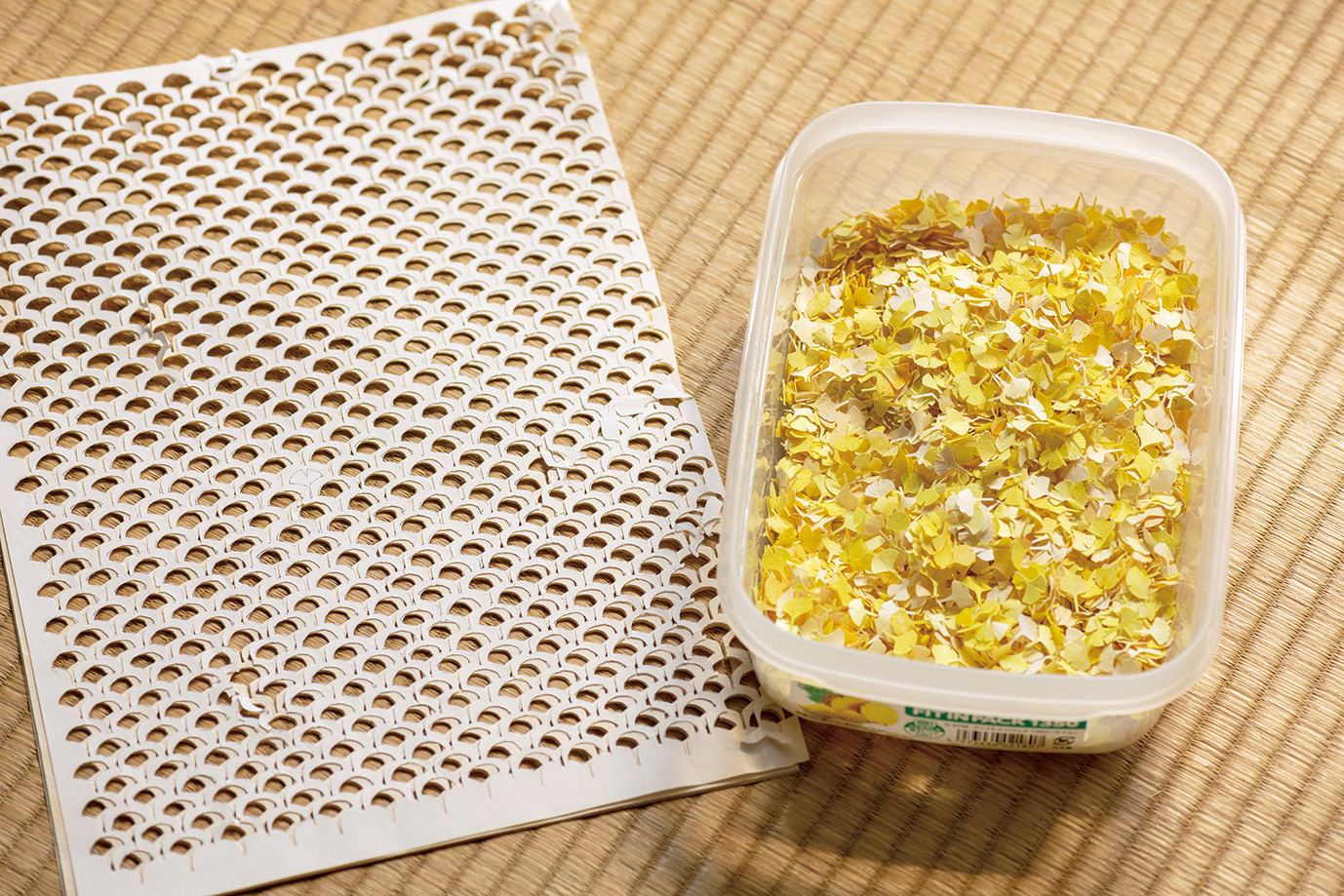
The parts used to make a ginkgo tree. Patterns drawn freehand are printed out, and the little pieces are cut out one by one.
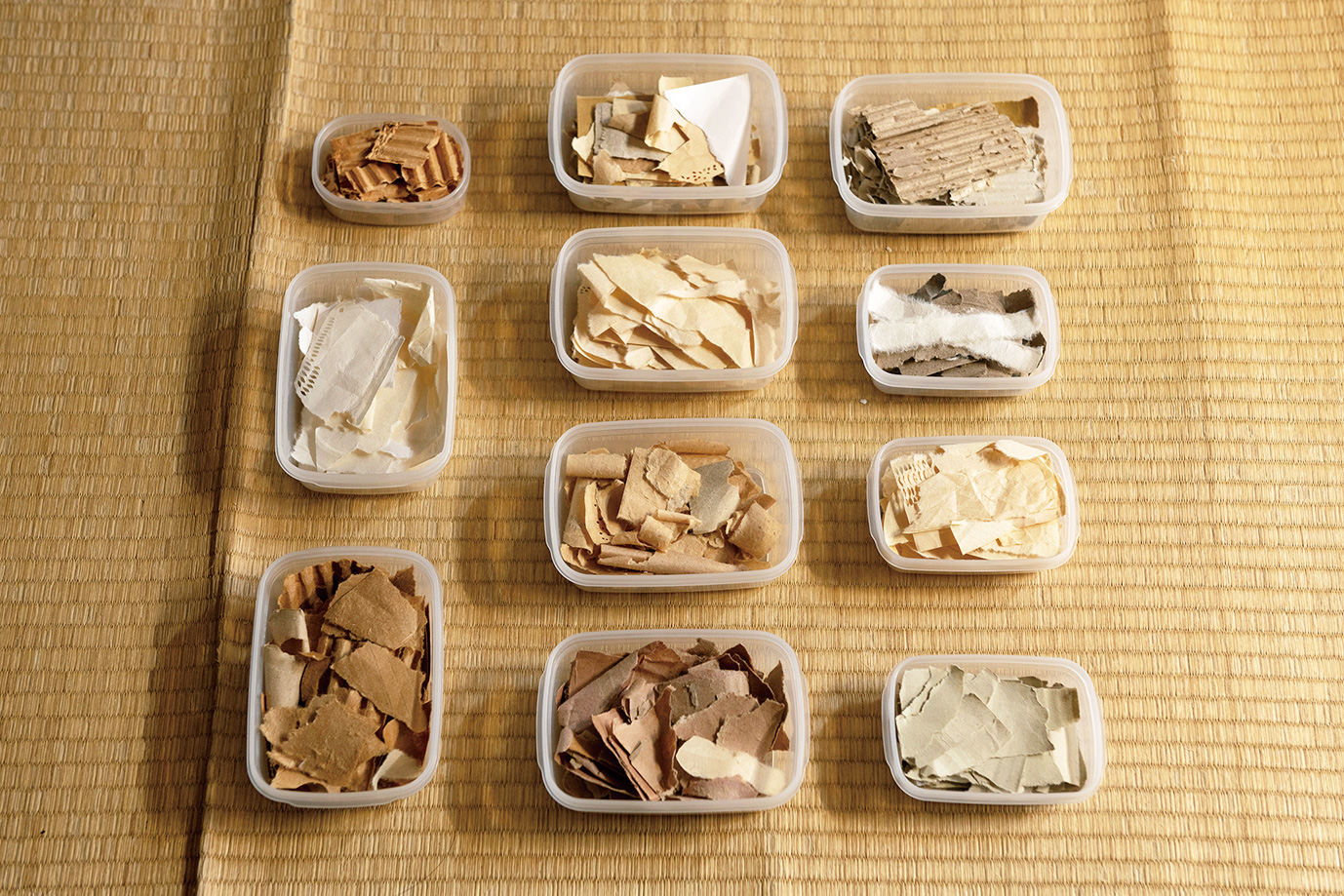
The parts used to make a ginkgo tree. Patterns drawn freehand are printed out, and the little pieces are cut out one by one.
He attended painting classes from an early age, he says, and had an affinity for drawing. After graduating from high school, he went on to an arts-focused university, where he majored in product design and tried producing works such as implements for day-to-day use. “There was an assignment that involved making lighting with washi, and it really made an impression on me, the textural feel of that paper and the gentle warmth it had when torn. I think that’s the original source that my current art creation developed from.”
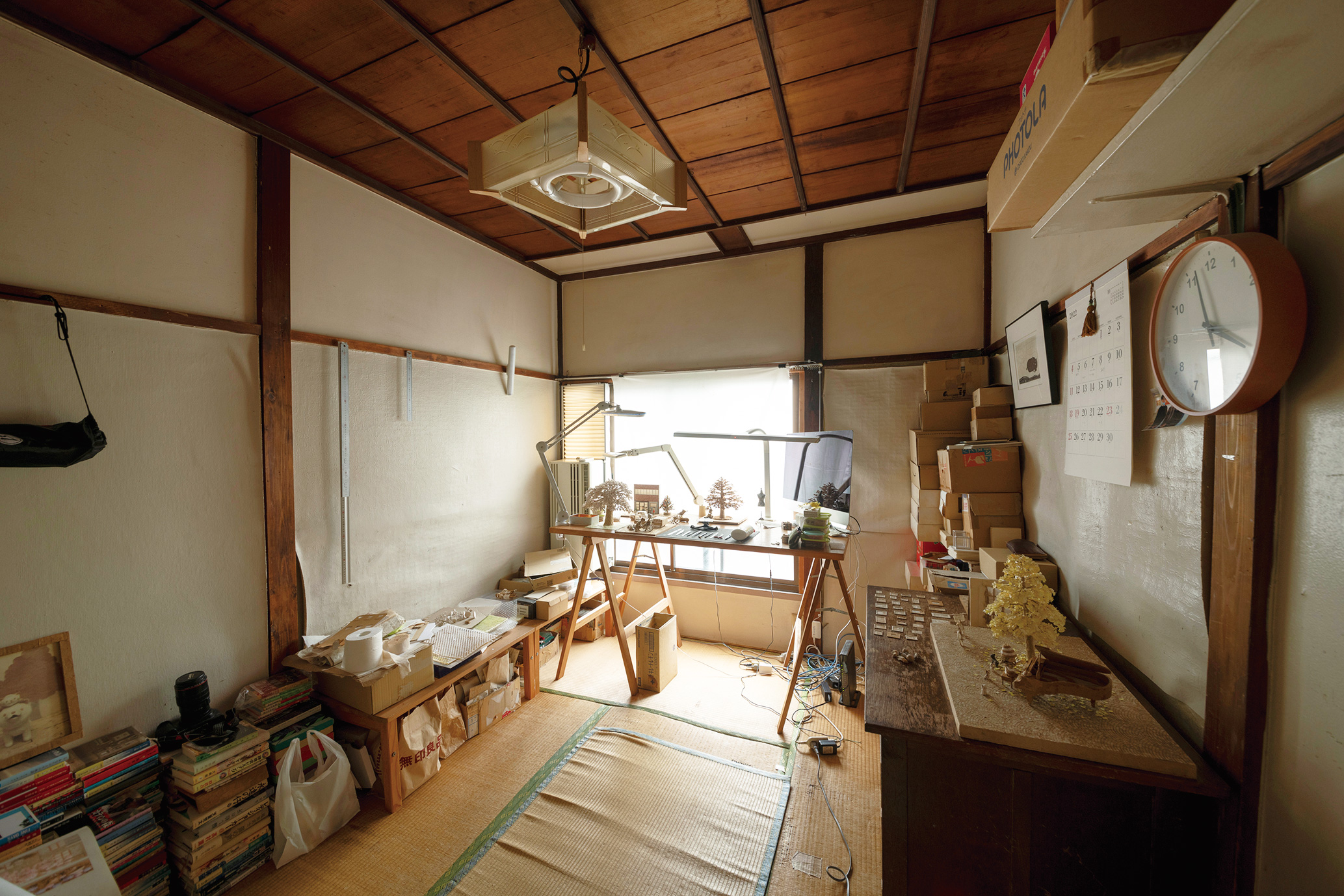
The artist’s studio, located on the 2nd floor of a 60-year-old retro building in a section of a shopping district with a traditional shitamachi working-class feel.
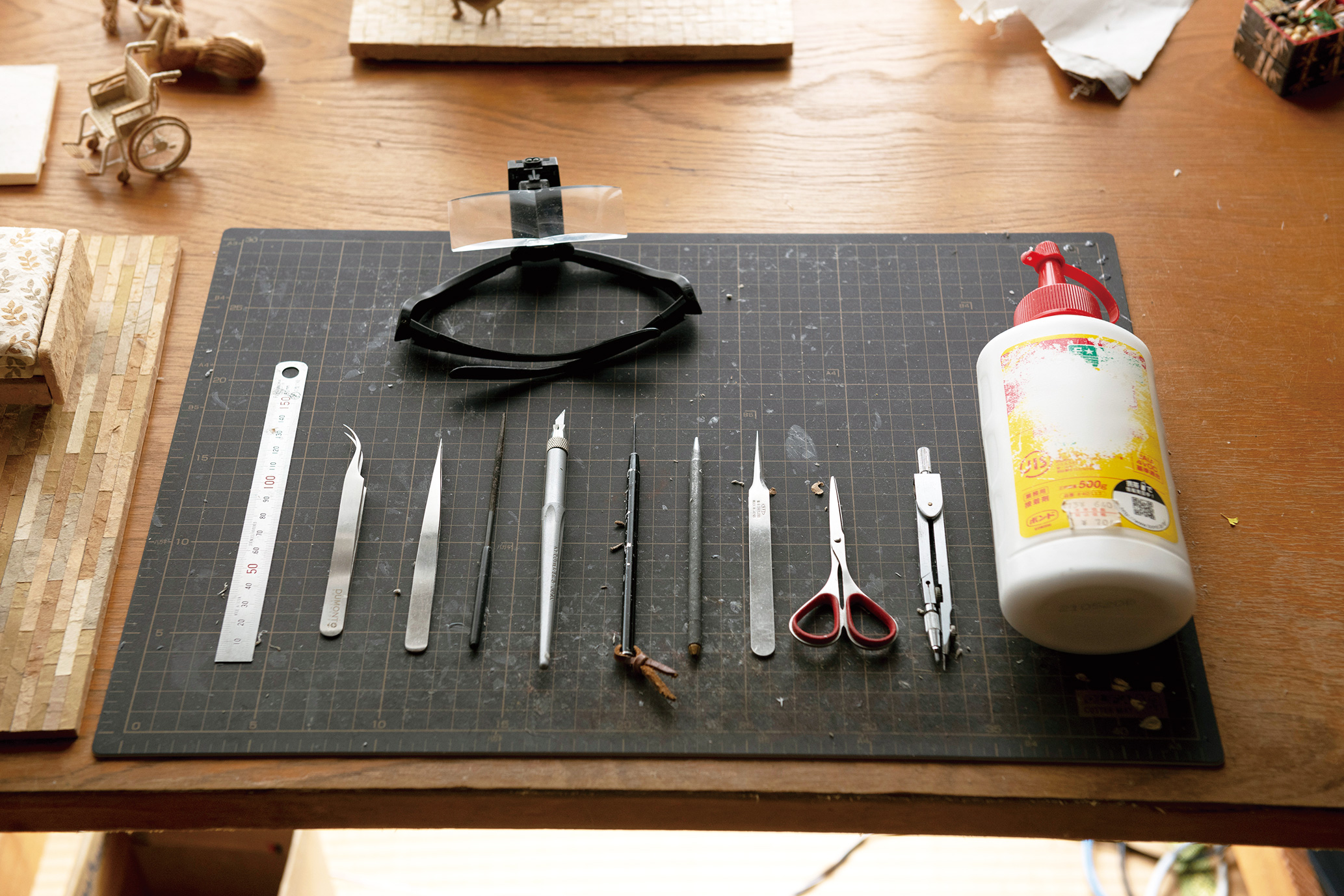
Only a minimal selection of implements is used. Bond wood glue from Konishi Co., Ltd. is a favorite of the artist.
Upon earning his degree, Kanazawa found employment at a design studio. While he would spend five and a half years working as a graphic designer, he arrived at a unique, original technique of his own in the creative artwork he continued to work on concurrently. With that, he had the confidence to go ahead with his dream of making a living as an artist, and his resolve strengthened. The work he presented in solo and other exhibitions made a splash, and he started getting contacts from publishers and production companies.
“I got to have my work that I’d made completely out of paper — not just people and animal miniatures alone, but the background scenery as well — displayed in a calendar. It’s always fun to make work with a sense of story, so I’d be really happy to get my art used as a visual complement to a narrative, like a book design.”
Finally, when asked what the future might have in store for him, Kanazawa replies, “I’d like to try working with some less ‘cute’ subject matter, maybe something scary.” Work by this artist featuring a broadened range of expression is something to look forward to, without a doubt.
